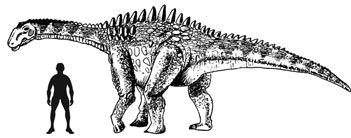Sauropods Nesting in the Same Location for Millions of Years
A team of palaeontologists have documented a remarkable Upper Cretaceous fossil site in Catalonia (Spain) and have discovered that this location was a nesting ground for many types of Late Cretaceous sauropods, At least four types of long-necked dinosaur eggs have been identified and from the study, published as an academic paper, it seems that the herbivorous megafauna of this part of Catalonia some 70 million years ago was very similar to the megafauna to be found in southern France during the Late Cretaceous.
Dinosaur Eggs
Scientists from the Miquel Crusafont Catalan Palaeontology Institute mapped the exposed Upper Cretaceous sediments in the Coll de Nargó palaeontological site (close to the village of the same name), in the western Catalonian province of Lleida. Up until this new study, only one type of sauropod egg, that of a titanosaur had been recorded in this region. This dinosaur is known as Megaloolithus siruguei, eggs attributed to this titanosaur species have been found in at least nine horizons in the Tremp geological formation in this part of the world. Average number of eggs laid per nest seems to be around 25 but a number of locations have been extensively eroded and Cenozoic plate movements has distorted a number of egg fossil bearing locations so pinning down the average size of a clutch of dinosaur eggs is very difficult.
A Typical Late Cretaceous Titanosaur from Europe (Ampelosaurus)
Picture credit: Everything Dinosaur
The picture above shows an illustration of a typical European titanosaurid dinosaur from the Late Cretaceous – Ampelosaurus. CollectA have made a figure of this titanosaur, it resides within the CollectA Age of Dinosaurs – Popular model range.
CollectA Age of Dinosaurs – Popular: CollectA Popular Models (Age of Dinosaurs).
A Detailed Analysis
After completing a detailed analysis of more than 25 different fossil bearing horizons in the Tremp Formation, the palaeontologists were able to conclude that there is evidence to support that at least four other types of sauropod used this area as a nesting site. Scientists have speculated that these large herbivores probably lived in herds and moved around extensively in search of food resources to satisfy their enormous appetites. It is likely that these reptiles migrated annually to favourite nesting grounds just like many birds and turtles do today.
Lead author of this new research, Albert García Sellés (Miquel Crusafont Catalan Palaeontology Institute) stated that:
“Eggshells eggs and nests were found in abundance and they all belong to dinosaurs, sauropods in particular. Up until now, only one type of dinosaur egg had been documented at this location, but now we have evidence to suggest four different types of dinosaur.”
Identifying Species
Identifying species of prehistoric animals from just remains of eggshells (and possibly embryos within the fossilised eggs), is referred to as analysing oospecies (working out the phylogenetic relationships between species – a study of ootaxa). Scientists are attempting to set up the evolutionary relationships between the animals that produced the eggs. Their work is complicated due to the seismic shifts in the sediments that once were deposited in a sequence of strata linking southern France and northern Spain, before the uplifting of the Pyrenees distorted the geological formations.
The additional oospecies named so far are Megaloolithus aureliensis, Megaloolithus baghensis and in the sister taxa Cairanoolithus roussetensis.
A Museum Exhibit Showing Titanosaur Eggs (Hypselosaurus)
Picture credit: Everything Dinosaur
The Tremp Formation
The strata that make up the Tremp Formation and other adjacent fossil bearing sediments were laid down in terrestrial environments. Although the team can estimate the relative age of the various fossil bearing horizons based on their stratigraphic sequence, the lack of zone fossils, otherwise known as guide fossils, is hampering their efforts to determine the absolute age of the strata and thus, the age of the fossils deposited therein. In marine sediments for example, small creatures with hard shells such as gastropods, or ammonites can act as biozone markers. These fossils are relatively abundant, distinct in appearance and they represent relatively rapidly evolving groups – ideal for acting as characteristic zone fossils to help identify the age of rock strata.
Different Types of Eggs
However, it has been noted that the different types of eggs (the oospecies) are located at very specific horizons. This has permitted the palaeontologists to develop a better understanding of the chronological age of each of the fossil bearing layers of rock. As a result, the scientists have determined that the rocks in this region represent a period in Earth’s history from 71 million years ago to approximately 66 million years ago (Maastrichtian faunal stage).
The fossilised eggs could contain clues to environmental changes that may have had a bearing on the mass extinction event that took place around 65-66 million years ago. This location is very significant to European palaeontologists as it provides a window into the very last days of the dinosaurs. It also shows that the megafauna in northern Spain was very similar to that of southern France during this time in the Late Cretaceous of Europe.
Nesting Colonies
In addition, the great volume of fossilised eggs and their spread across different stratigraphic horizons provides the scientists with very strong evidence to suggest that titanosaurs used this area of Spain as a nesting site for millions of years. The presence of various oospecies at the same horizon also suggests that different species of titanosaur shared the same nesting area, perhaps in a similar way to many extant sea-birds sharing nesting colonies today.
Fossil strata containing evidence of dinosaur eggs and nests within the Tremp Formation were once part of a continuous low-lying basin that extended for hundreds of miles. However, the collision of the Iberian and the European plates which began at the end of the Cretaceous and extended into the Oligocene Epoch led to extensive uplifting and the creation of the mountain range that now divides Spain and France – the Pyrenees.







Leave A Comment